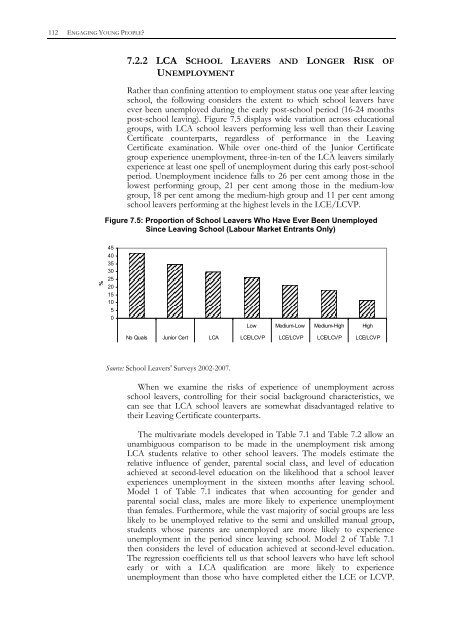Student Experiences of the Leaving Certificate Applied Programme
Student Experiences of the Leaving Certificate Applied Programme
Student Experiences of the Leaving Certificate Applied Programme
You also want an ePaper? Increase the reach of your titles
YUMPU automatically turns print PDFs into web optimized ePapers that Google loves.
112 ENGAGING YOUNG PEOPLE?7.2.2 LCA SCHOOL LEAVERS AND LONGER RISK OFUNEMPLOYMENTRa<strong>the</strong>r than confining attention to employment status one year after leavingschool, <strong>the</strong> following considers <strong>the</strong> extent to which school leavers haveever been unemployed during <strong>the</strong> early post-school period (16-24 monthspost-school leaving). Figure 7.5 displays wide variation across educationalgroups, with LCA school leavers performing less well than <strong>the</strong>ir <strong>Leaving</strong><strong>Certificate</strong> counterparts, regardless <strong>of</strong> performance in <strong>the</strong> <strong>Leaving</strong><strong>Certificate</strong> examination. While over one-third <strong>of</strong> <strong>the</strong> Junior <strong>Certificate</strong>group experience unemployment, three-in-ten <strong>of</strong> <strong>the</strong> LCA leavers similarlyexperience at least one spell <strong>of</strong> unemployment during this early post-schoolperiod. Unemployment incidence falls to 26 per cent among those in <strong>the</strong>lowest performing group, 21 per cent among those in <strong>the</strong> medium-lowgroup, 18 per cent among <strong>the</strong> medium-high group and 11 per cent amongschool leavers performing at <strong>the</strong> highest levels in <strong>the</strong> LCE/LCVP.Figure 7.5: Proportion <strong>of</strong> School Leavers Who Have Ever Been UnemployedSince <strong>Leaving</strong> School (Labour Market Entrants Only)%454035302520151050Low Medium-Low Medium-High HighNo Quals Junior Cert LCA LCE/LCVP LCE/LCVP LCE/LCVP LCE/LCVPSource: School Leavers' Surveys 2002-2007.When we examine <strong>the</strong> risks <strong>of</strong> experience <strong>of</strong> unemployment acrossschool leavers, controlling for <strong>the</strong>ir social background characteristics, wecan see that LCA school leavers are somewhat disadvantaged relative to<strong>the</strong>ir <strong>Leaving</strong> <strong>Certificate</strong> counterparts.The multivariate models developed in Table 7.1 and Table 7.2 allow anunambiguous comparison to be made in <strong>the</strong> unemployment risk amongLCA students relative to o<strong>the</strong>r school leavers. The models estimate <strong>the</strong>relative influence <strong>of</strong> gender, parental social class, and level <strong>of</strong> educationachieved at second-level education on <strong>the</strong> likelihood that a school leaverexperiences unemployment in <strong>the</strong> sixteen months after leaving school.Model 1 <strong>of</strong> Table 7.1 indicates that when accounting for gender andparental social class, males are more likely to experience unemploymentthan females. Fur<strong>the</strong>rmore, while <strong>the</strong> vast majority <strong>of</strong> social groups are lesslikely to be unemployed relative to <strong>the</strong> semi and unskilled manual group,students whose parents are unemployed are more likely to experienceunemployment in <strong>the</strong> period since leaving school. Model 2 <strong>of</strong> Table 7.1<strong>the</strong>n considers <strong>the</strong> level <strong>of</strong> education achieved at second-level education.The regression coefficients tell us that school leavers who have left schoolearly or with a LCA qualification are more likely to experienceunemployment than those who have completed ei<strong>the</strong>r <strong>the</strong> LCE or LCVP.

















